According to some reports: Turkish DPICM cluster shells for Ukraine
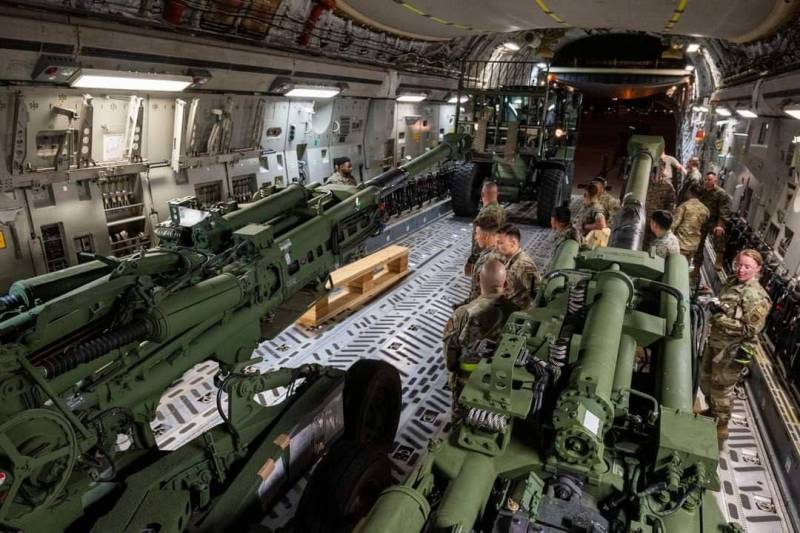
American howitzers M777 for Ukraine
Over the past months, the Kyiv regime has been receiving various artillery systems and ammunition for them from foreign partners. The other day it became known that Turkey became the next supplier of ammunition. At the same time, products with cluster combat equipment are shipped from the arsenals of the Turkish army. Such shells pose an increased danger, and in addition, their supply may be associated with a violation of international agreements.
According to the press
The new direction of Turkish-Ukrainian military-technical cooperation was reported on January 10 by the American edition of Foreign Policy. The publication received information about it from its sources in the US and Europe, who are familiar with the situation. It also tried to get comments from the Turkish embassy in the United States and the Ukrainian Ministry of Defense - but both departments refused to answer questions.
According to FP sources, over the past few months, Kyiv has been begging Washington for dual-purpose improved conventional munition (DPICM) cluster-type artillery munitions. However, the US refused to supply such products for technical and political reasons.
However, Ukraine still received the desired ammunition. The delivery of DPICM shells began in November last year, and Turkey acted as the sender. The supplied shells were manufactured by the Turkish industry under an American license during the Cold War. Until recently, they lay in the warehouses of the Turkish army, and now they are written off and sent to Ukraine.
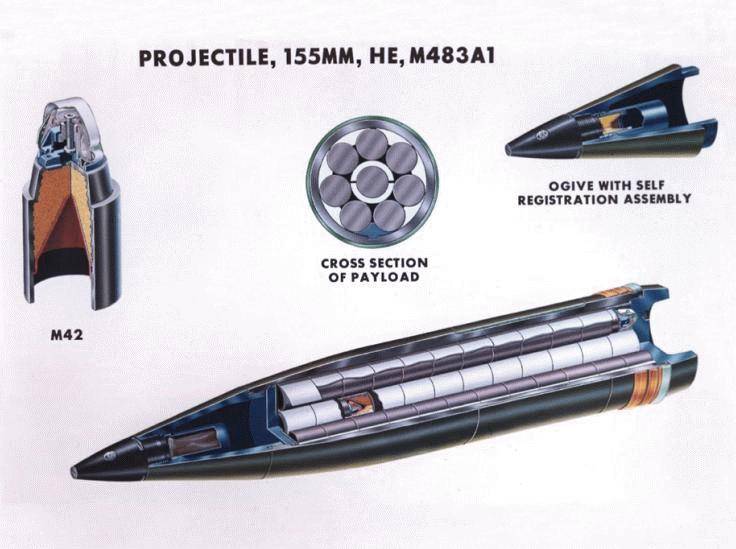
Projectile M483A1 caliber 155 mm
Foreign Policy was unable to find out what stocks of such shots Turkey has. There is also no information on the volume of deliveries. In addition, the use of the transferred shells by Ukrainian formations has not yet been reported.
Legal Issues
The American edition not only reports on the supply of DPICM shells, but also reveals the legal features of these processes. It notes that Turkey's current actions are inconsistent with its previously voiced position on cluster munitions.
The fact is that in 2021 the Turkish leadership expressed a desire to join the current international Convention on Cluster Munitions. Turkey, in a corresponding letter to the supervisory body of the Convention, wrote about its commitment to the cause of peace and disarmament, and also indicated that since 2005 it has not been producing, using, importing or exporting weapon with cassette equipment.
Now the situation has changed - Turkey has begun transferring cluster munitions to a third country. FP tries to analyze this policy change and offers his explanations. In addition, other deliveries of Turkish military products to Ukraine are recalled in this context.
"Dual Purpose Ammunition"
The first Dual-Purpose Improved Conventional Munition projectile ("Improved conventional dual-use ammunition") was adopted by the US Army in 1975 under the designation M483. It carried 88 combat elements of two types and was intended to combat manpower and armored vehicles - this is what was designated as "dual use". The 155 mm DPICM cluster projectile was considered as an addition to the existing 105 mm M444 APICM product with anti-personnel submunitions.
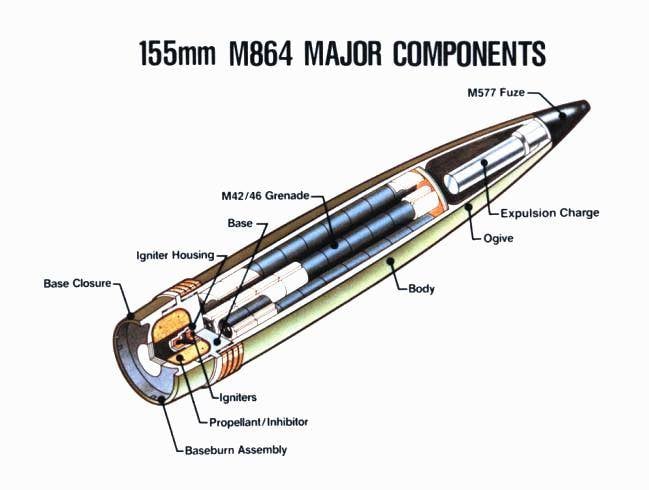
Active Rocket M864
In the eighties, a 155-mm M864 projectile was created with similar equipment and a bottom gas generator, due to which the firing range was increased. In addition, in the late nineties, M915 and M916 shells appeared for modern 105-mm howitzers. The M915/916 allowed the old M444 to be retired.
Early cluster shells managed to be used in Vietnam. In general, they confirmed the calculated combat qualities, but at the same time showed significant shortcomings. So, about 3% of submunitions did not work when they fell and remained lying on the ground, posing a threat and requiring attention. In this regard, in later modernization projects, new contact fuses with a self-liquidator were introduced.
In the tenth years of the XXI century. The Pentagon has reviewed the status of its DPICM stocks and has decided to phase out such projectiles from service. This decision was led by the moral and physical obsolescence of products, as well as the risks of their further storage and operation. Since the middle of the last decade, a program for the disposal and conversion of existing DPICMs has been carried out. Submunitions are removed from the shells and sent for further disassembly. The hulls are used to make practical munitions and the explosives are recycled.
At one time, the United States supplied DPICM shells to some foreign countries. In addition, licensed production of such products was carried out in Turkey and other states. After the end of the Cold War, the bulk of the armies abandoned such shells and disposed of them. Turkey, in turn, retained at least part of its reserves. If the information from Foreign Policy is true, then now it gets rid of unnecessary shots through export.
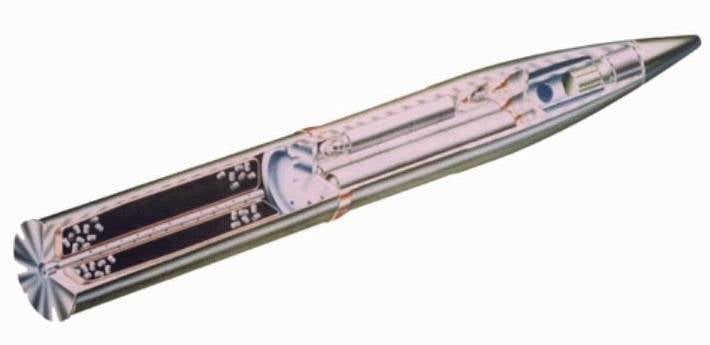
Smaller caliber M915 projectile
Cassette equipment
The DPICM range of artillery shots includes four types of projectiles and their modifications. In the 105 mm caliber, the M915 and M916 products were made. For 155 mm guns, the larger and heavier M483(A1) and M864 are intended.
It was possible to place 155 elements in the 88 mm caliber case: 24 fragmentation-cumulative M46 and 64 smaller fragmentation M42. Fragmentation ammunition hit manpower within a radius of several meters, and cumulative pierced approx. 100 mm homogeneous armor. 105-mm shells contained 42 M80 fragmentation-cumulative elements. Due to their smaller size and weight, they showed more modest characteristics.
DPICM projectiles of all types were intended to destroy stationary area targets of various kinds and were generally considered as an alternative to conventional "blanks". Due to the dispersion of small submunitions over a large area, a high probability of hitting individual "soft" targets was ensured and the consumption of projectiles was reduced. Fragmentation-cumulative submunitions of various types could hit armored vehicles, but their small size and power did not guarantee the destruction of all targets in the area.
Threat and response
Deliveries of foreign artillery shells to Ukraine pose a certain danger to our troops and the population of the liberated territories. Ukrainian artillery regularly shells populated areas, causing serious damage to residential areas and civilian infrastructure. It is possible that the received DPICM projectiles will also be used in such shelling.
The results of these attacks will look different. Unlike a high-explosive fragmentation projectile, a cluster projectile can damage targets over a larger area, although detonating a single submunition does less damage. At the same time, the risks for the population will increase. In addition, there will be a problem of failure of individual combat elements - they will create an additional threat and add work to our sappers.
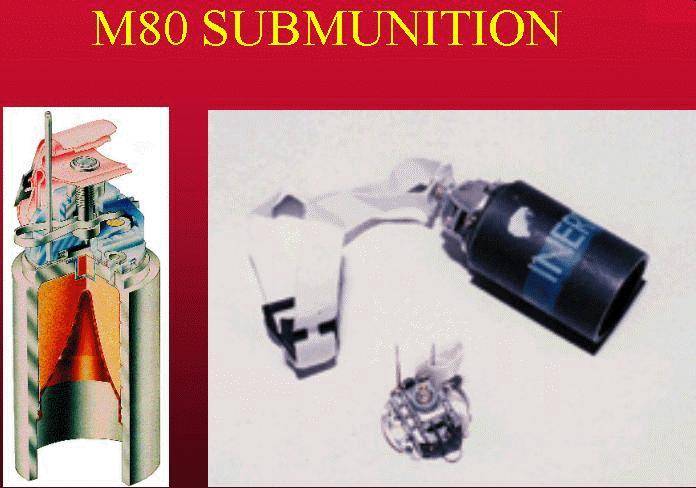
M80 combat element
Artillery shells with cluster equipment can be classified as weapons of indiscriminate action. Their use in a populated area and civilians would be a clear war crime. However, the notorious world community will once again pay no attention to these events. Or he will notice him, but habitually blame the Russian army for the shelling of Donbass.
Our armed forces should take into account the new threat and take measures to eliminate it. In general, the methods of such struggle are well known. It is necessary to find and destroy warehouses of rocket and artillery weapons, guns with crews in positions and in the rear. The interception of artillery shells is not yet possible, and therefore it is necessary to prevent the very fact of a shot. It is also necessary to maintain an effective and developed system of counter-battery combat.
Potential hazard
So far, only the American edition of Foreign Policy has reported on the supply of Turkish cluster shells to Ukraine. Decent confirmation of this information has not yet been received. DPICM projectiles have not yet been seen in the combat zone either. However, the experience of recent months shows that only a few days can pass from the appearance of unofficial information to the arrival of weapons at the front.
Whether there is a real threat in the form of DPICM cluster projectiles is not yet clear. However, the lack of clear information does not preclude the need to prepare for new risks. Our army has the necessary means and skills, and it can be expected that even a new batch of foreign shells will not help the Ukrainian formations.
Information